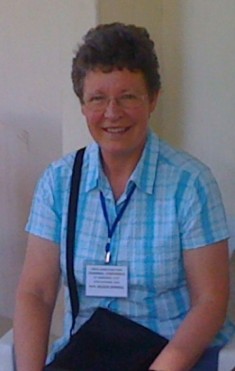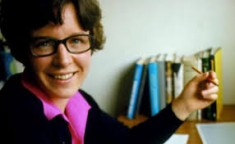| Jocelyn Bell Burnell | |
|---|---|
 |
|
| Astrophysicist | |
| Specialty | Pulsars |
| Born | July 15, 1943 Belfast, Northern Ireland, UK |
| Nationality | Northern Irish |
Born on July 15, 1943, in Belfast, Northern Ireland, Jocelyn Bell Burnell is a prominent astrophysicist, famous in particular for her significant contribution to the discovery of the first four radio pulsars during her postgraduate studies, together with British radio astronomer Antony Hewish, who was her thesis supervisor and head of the astronomy department at the University of Cambridge.
Early Life and Education
From an early age, Burnell showed a great interest in books on astronomy and she was among the first girls at Lurgan College who was allowed to study science. When she was eleven, she was sent to the Mount School, a Quaker boarding school for girls located in York and ever since, she has been an active Quaker.
She studied at the University of Glasgow and in 1965, she earned her Bachelor of Science degree in physics. In 1969, she was awarded a doctorate in radioastronomy from the New Hall, University of Cambridge. Her 1968 doctorate thesis was entitled The Measurement of Radio Source Diameters Using a Diffraction Method.
Burnell’s Major Discovery
While working as a research assistant at Cambridge she helped Antony Hewish and other astrophysicists construct a large radio telescope (called the Interplanetary Scintillation Array) for the purpose of using interplanetary scintillation (random fluctuations in terms of the intensity of celestial radio waves) to study quasi-stellar radio sources or quasars. Although her work was not properly acknowledged and she did not receive the Nobel Prize, Bell was still recognized as the astronomer who observed on November 28, 1967, the first radio pulsar (a highly magnetized neutron star which emits a beam of electromagnetic radiation), which was initially named CP 1919 (now 1919+21).
Nobel Prize Controversy
 Although in the paper announcing the breakthrough discovery her name was listed second (the paper had five authors), only Hewish and fellow radio astronomer Martin Ryle were co-recipients of the Nobel Prize for Physics in 1974. At that moment, the fact that she was not awarded the Nobel Prize as well, primarily due to her student status, was quite controversial and some notable scientists including English astronomer Sir Fred Hoyle referred to the first Nobel Prize awarded in recognition of groundbreaking research in astronomy as the ”No-Bell Nobel Prize.”
Although in the paper announcing the breakthrough discovery her name was listed second (the paper had five authors), only Hewish and fellow radio astronomer Martin Ryle were co-recipients of the Nobel Prize for Physics in 1974. At that moment, the fact that she was not awarded the Nobel Prize as well, primarily due to her student status, was quite controversial and some notable scientists including English astronomer Sir Fred Hoyle referred to the first Nobel Prize awarded in recognition of groundbreaking research in astronomy as the ”No-Bell Nobel Prize.”
Nevertheless, she was not upset with the decision of the Nobel Prize committee and showed no bitterness towards her doctoral advisor. Nowadays, it is universally acknowledged that “the greatest astronomical discovery of the 20th century” (according to Russian astronomer Iosif Shklovsky) was essentially Bell’s. In 2013, Dame Susan Jocelyn Bell Burnell was included in the 100 most powerful women in the UK list by BBC Radio 4 and her contribution to the development of astrophysics was explored in the first part of BBC Four’s Beautiful Minds series.
Working with Astrophysics
In 1967, while checking the printouts of her experiments tracking radio sources of celestial origin, she discovered radio pulses that were extremely regular (one pulse per second). Although the source was initially referred to as LGM-1 (Little Green Men), believing that it represented an attempt at communication by extraterrestrial organisms, Bell, Hewish, and the rest of the team discovered that the radio waves emanated in fact from rapidly spinning neutron stars, which were called pulsars in 1968.
Career Highlights
From 1970 until 1973, she served as Professor of Physics at the University of Southampton, then at the University College London from 1974 until 1982. She also worked at the Royal Observatory in Edinburgh from 1982 until 1991 and as Professor of Physics at Open University from 1991 until 2001, when she was appointed as Dean of Science at the University of Bath, a position she held until 2004.
Awards and Honors
Throughout her outstanding career in astrophysics, she has been awarded a large number of honorary degrees for her significant scientific work, including Doctor of the University: University of York in 1994, Doctor of Science: University of Glasgow (1997) and Harvard University (2007).
In 1989, she received the Herschel Medal awarded by the Royal Astronomical Society for her outstanding work in the field of observational astrophysics and from 2002 until 2004, the famous astrophysicist served as President of the Royal Astronomical Society. In 1999, she became Commander of the Order of the British Empire (CBE) for her contribution to the development of astronomy and in 2007 she was made Dame Commander of the Order of the British Empire (DME).
The famous Northern Irish astronomer currently serves as Visiting Professor of Astrophysics at Oxford and as Fellow at Mansfield College. Bell Burnell continues to support the presence of women in academic positions in the areas of astronomy and physics.